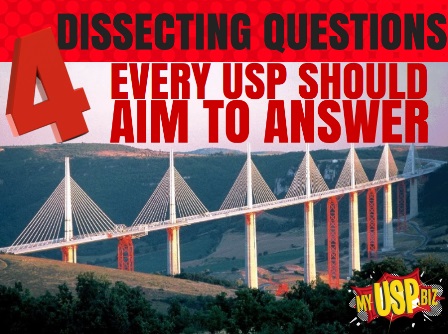
Your USP [Utterly Seductive Proposal] has several jobs to do on your behalf. If you are going to the trouble of constructing one, let’s make it work as hard as possible for you. There are 4 vital questions all USPs should aim to answer. This isn’t easy mind you.
1. Who are you?
2. Why I should trust you?
3. Why should I listen to you?
4. Why I should buy from you right now compared to doing nothing at all?
These are four vital questions most purchase decisions have to pass successfully. Can you answer them immediately about your business? It is not easy unless you have prepared yourself by in-depth analysis of what you stand for and what difference you make to others. To maximise every potential sales opportunity you will need to become fluent is answering all of the above four questions.
1. Who are you?
This is the hardest to work into a USP as it takes up so much space and considering we’re making a headline type of statement, it’s the least important. Ideally include it, but make it no.4 on the above list . If I, as a potential customer, do not know who you or your company are, I will naturally not feel any trust towards you [warm referrals aside]. I don’t need to know your preferred item from the McDonald’s menu or your favourite Oasis tune, but basic a level of confidence would be good. This is not easy to convey in a USP especially short ones.
2. Why should I trust you?
The second question is again coming back to trust again, why should I trust you? The challenge in any sales situation is that the buyer will naturally think back to a time when he or she did not get what they thought they were signing up for. They’ll recall a negative experience when the deal didn’t work out well in terms of the value promised. Resilience is to be expected from anyone. Without any trust your words are going to be falling on deaf ears. Why should anyone listen to you? Make sure your USP enthuse the reader with a feeling of what it is like to have bought from you. The owning experience is what it is all about in most cases so attempt to sum it up boldly but pleasantly.
3. Why should I listen to you?
I mentioned before what the main reason is behind us buying things? People buy for one reason and one reason only – to solve a problem. You USP can address a problem or offer a solution or a problem. Most purchases are because we ‘want’ to and not because we ‘have’ to. If you let someone decide later your chances of making that sale diminish massively. I’d say to about 15% or less. What does, “I’ll think about it,” mean? A small percentage may wish to think about it but it is usually a polite way to say no.
If no one is listening to you you’re back to being invisible and what did we say previously about people buying from the invisible man? You must give good reasons for prospects to stop what they are doing and turn their observations your way. They need valuable reasons to pay attention to you, and generally these come down to problem solving again. We touched before on the phrase ‘what’s in it for me’. Well, ask yourself, why IS in it for your existing customers? Why do they buy from you? What are they buying from you that they cannot provide for themselves? You do not always listen to someone simply because he is cheap, or because there’s a free trial period. I don’t want cheap dried apricots [I’m not a fan] and I definitely do not have time for a complimentary trial of ‘Table Tennis Today’ magazine, even if it actually exists? To create an audience, genuinely desirable benefits must be uncovered and relayed clearly.
4. Why should I buy from you right now?
Finally, you must create a sense of urgency. If you don’t instil the ‘hurry up and do it now’ into your prospects’ minds it’s another reason for them not to buy from you right now, and the more time that passes, the less likely they are to come back to you. They may even decide to never make the acquisition. If your target customers do not buy today, or imminently, they will experience either some sort of loss or increased pain. Either way, it isn’t good. How can you explain the need for them to do it right now? Delaying only makes the problem bigger and more painful. A decision has to be made at some point so why go away and begin the whole process again at a later date, wastefully duplicating efforts? Suggest they remove ‘time’ from the equation and make a positive decision.
Tim Coe
Why not follow me on Twitter for more marketing gems?
Follow @myUSPbiz



